
Optic fibre technology has revolutionised the way we communicate and access information in the modern world. From faster internet speeds to more reliable connections, optic fibre technology has significantly improved our digital lives. But did you know that this innovative technology also has environmental benefits?
One of the most noticeable environmental benefits of optic fibre technology is its energy efficiency. Optic fibres transmit data using light signals, which require less energy compared to traditional copper cables. This means that optic fibre networks consume less electricity, resulting in lower carbon emissions and reduced energy costs.
Additionally, optic fibre technology has a longer lifespan than copper cables, which often need to be replaced or repaired due to corrosion or wear and tear. This not only reduces the amount of waste produced but also decreases the need for resources to manufacture new cables.
Furthermore, optic fibre technology has a smaller physical footprint compared to traditional cables. Optic fibres are much thinner and lighter than copper cables, allowing for more compact and efficient network installations. This not only saves space but also reduces the impact on the environment, particularly in urban areas where space is limited.
Optic fibre networks also enable more efficient transportation and communication systems, which can lead to a reduction in greenhouse gas emissions. For example, the use of optic fibre technology in smart grids can help monitor and optimise energy distribution, leading to energy savings and reduced emissions. Additionally, high-speed internet access enabled by optic fibre technology can promote telecommuting and video conferencing, reducing the need for travel and decreasing carbon emissions from commuting.
Overall, optic fibre technology offers numerous environmental benefits that can help mitigate the impacts of climate change and promote sustainability. As the demand for high-speed internet continues to grow, investing in optic fibre technology can provide both economic and environmental advantages. By choosing optic fibre technology, we can build a more sustainable and interconnected world for future generations.
